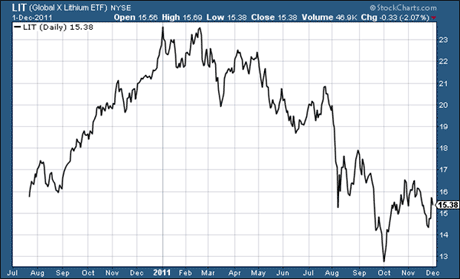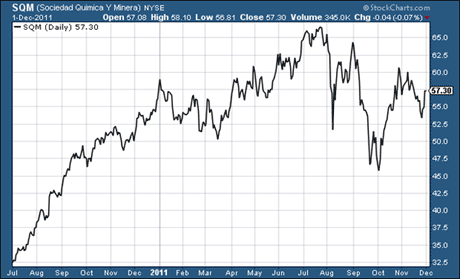Lithium batteries power something like 90% of laptops, 60% of mobile phones and somewhere in between for tablets. They’re also being used more and more in power tools and vehicles.
Just yesterday, BMW and Toyota signed a memorandum of understanding to pool research on lithium ion batteries. Klaus Draeger, BMW’s head of research and development, said at a press briefing in Tokyo: “By carrying out basic research together, we want to speed up the development of battery cell technologies”, which, he said, are crucial for the future of hybrid vehicle technology.
So there’s a case for investing in lithium.
But here are the big questions: how do you go about it – and should you do it now?
The trouble with tech stocks
The world’s appetite for lithium batteries is growing – at about 20% per year. Lithium-ion batteries are lighter, store more energy, and retain their charge longer than their nickel-based rivals. And you don’t have to wait for them to run down before you re-charge them.
However, I’m averse to investing in the battery technology companies themselves. The general problem I have with tech is the speed with which it moves. You can pick a company that’s a market leader, then watch it crash as a previously unknown entity comes along with a superior technology.
In the great Alaskan gold rush those who sold picks and shovels apparently made more money than the prospectors themselves. So there’s an argument to be made for simply buying lithium, which we know is going to be used in battery technology, as a picks-and-shovels play.
You can’t just buy physical lithium in the way you would buy gold or silver. Apart from anything else, it’s highly reactive and would spontaneously combust. But there is a lithium exchange-traded fund (ETF). It trades on the NYSE under the ticker LIT. The chart is below.

It made a high at the end of 2010, re-tested that high in February, and it’s been declining ever since. There are signs it has turned back up, having made a low in early October, but it’s not what you’d call a compelling uptrend.
The fact is, that could just as easily be a chart of copper, the commodities index, the Canadian venture exchange, an index of junior gold explorers, the Brazilian stock exchange, the euro at a stretch – they’re all virtually interchange-able. (Perhaps not the euro – that peaked in May, along with the S&P 500. But you take my point.)
Lithium is a ‘risk-on’ trade
The trouble is, lithium – for all its newfound uses – is just another manifestation of the liquidity story. There is a great deal of cash, credit, leverage – whatever you want to call it – looking for a home.
When sentiment is bullish, we hear all about the lack of investment in commodity production, the pending energy crisis, the increasing wealth of the emerging market middle class, their desire for the things we take for granted in the West, and all those other compelling stories.
When sentiment turns negative, these same stories are ignored in the flight to cash, which is usually accompanied by a rise in the US dollar.
This ‘risk on, risk off’ phenomenon gripping markets makes it hard to time investments in these more obscure areas of the market. So my stance on the lithium ETF is this: if you think markets are due for a run higher, get long. If you think they’re due a correction, get out.
However, there’s no doubt that demand for these batteries will continue to grow. If you’re looking for exposure to that story, perhaps a better option is the lithium producers. The world’s biggest is Sociedad Quimica y Minera De Chile (NYSE: SQM). It significantly outperformed lithium in 2011 before suffering a nasty correction, which began in the summer.

So if you are interested in the long-term lithium story, you’d do well to look to the miners, rather than the metal.
Category: Investing in Technology

